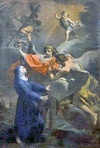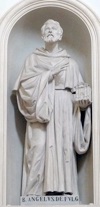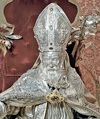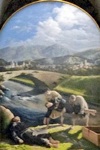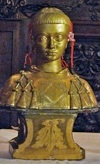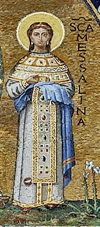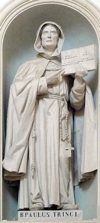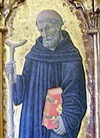Blessed Angela of Foligno (4th January)
Angela was born in Foligno in ca. 1249. When her husband and children died suddenly in ca. 1288, she joined the Franciscan Third Order. She became a renowned mystic in her lifetime and a spiritual advisers to a number of Franciscan friars. She died in 1309 and was buried in San Francesco.
Blessed Angelina of Montegiove (14th July)
Angelina joined, the Franciscan tertiaries at the the Monastero di Sant' Anna soon after its formation by the Blessed Paolucccio Trinci (below) in ca. 1390. She became its leader and it subsequently became the centre of a Congregation, with Angelina as its first Minister General. She died in 1435 and was buried in San Francescowhere her relics are still venerated. Her cult was confirmed for Foligno in 1825.
Blessed Angelus of Foligno (27th August)
Angelo Conti, who was born at Foligno in 1226, was a hermit and later the founder of Sant' Agostino, Foligno. He died here in 1312and his relics are still venerated in the church. Pope Leo XIII approved his cult for Foligno in 1881.
SS Carpophorus and Abundius (10th December)
SS Carpophorus and Abundius (respectively a priest and a deacon) were beheaded in the reign of the Emperor Diocletian. They also appear in the Legend of the Twelve Syrians. They were arrested and executed in Foligno. A sarcophagus (6th or 7th century) that came from Santa Maria in Campis, Foligno, which was believed to have contained their relics, was moved to Palazzo Trinci and destroyed in the bombing of 1944.
St Dominic of Sora (22nd January)
St Dominic of Sora (951-1032) was born in Foligno. He became Benedictine monk and founded a number of hermitages in Central Italy that were associated with the reforming papacy. He died at his monastery at Sora, where his relics are preserved. He was remembered for his miracles, and particularly for the cure of snake bites.
St Felician (24th January)
Pope
Victor I (189-99) ordained St Felician as the first bishop of Forum Flaminii. He seems to have been a formidable preacher and evangelist. He was martyred outside Foligno and buried on the site of the present Duomo. Bishop
Theoderic of Metz took the relics to Metz in 970 but some of them were returned to Foligno in the 17th century. St Felician remains the patron saint of Foligno, and a fine statue of him (illustrated here) is taken in procession each 24th January.
Blessed James and Philip (2nd September)
These two friars from San Francesco were wrongly accused of treason in 1377 and executed on the orders of Trincio Trinci at Bevagna. Their bodies were thrown in the Topino there but they miraculously floated to Foligno. They were recovered from the river and translated to San Francesco.
St Maron (9th February; 17th August)
This reliquary in the crypt of the Duomo is believed to contain the cranium of St Maron, for whom the Maronite Church is named. According to local tradition, the relic was brought to Sassovivo in the 12th century and subsequently housed in a church that was built for it at nearby
Volperino di Foligno. It was translated to the Duomo in 1490.
St Messalina (23rd January)
The young Messalina was recognised as a Christian when she visited St Felician (above) in prison, and was clubbed to death.
Blessed Paoluccio Trinci (14th September)
The Blessed Paoluccio (died 1391) belonged to the conventual Franciscan community of Foligno but was allowed to develop an eremetical community at San Bartolomeo di Brogliano. This formed the basis of a small congregation that developed into the congregation of Observant Franciscans.
Blessed Peter Crisci (19th July)
Blessed Peter Crisci, who lived as a hermit in the campanile of the Duomo, died in 1323 and became the subject of a popular cult in Foligno.
Blessed Tomasuccio of Foligno (15th September)
The Blessed Tomasuccio lived as a hermit outside Gualdo Tadino for some 24 years until ca. 1370. He then spent a period in Tuscany, during which he became famous for his prophecies, and finally moved to Foligno. He probably belonged to the quasi-Franciscan group known as the Clareni, and received the attentions of the Inquisition on at least three occasions. He ended his life in ca. 1400 at the Osepdale della SS Trinità, Foligno and his relics are preserved in Sant, Agostino there. His cult has never received papal confirmation.
St Vincent (24th May) and St Florentius (1st June)
According to Ludovico Jacobilli, these were two of the 300 saints who travelled from Syria to Italy in the 6th century, and who then spread out across Umbria:
-
✴St Vincent was bishop of Foligno in 523-51.
-
✴St Florentius (illustrated here) originally settled in a hermitage outside Norcia but then moved to Foligno. St Vincent established a hermitage for him outside the city and, when he died there eight years later (in 548 or 550), arranged his burial in the Duomo. After the restoration of the Duomo in 1146, it was re-dedicated as SS Giovanni Battista, Feliciano et Florentio (albeit that it soon reverted to St Felician alone).
The legends as compiled by Jacobilli are unreliable, although relics of a St Florentius (although probably not from Syria via Norcia) were probably in the Duomo in 1146.
Return to the home page on Foligno.


